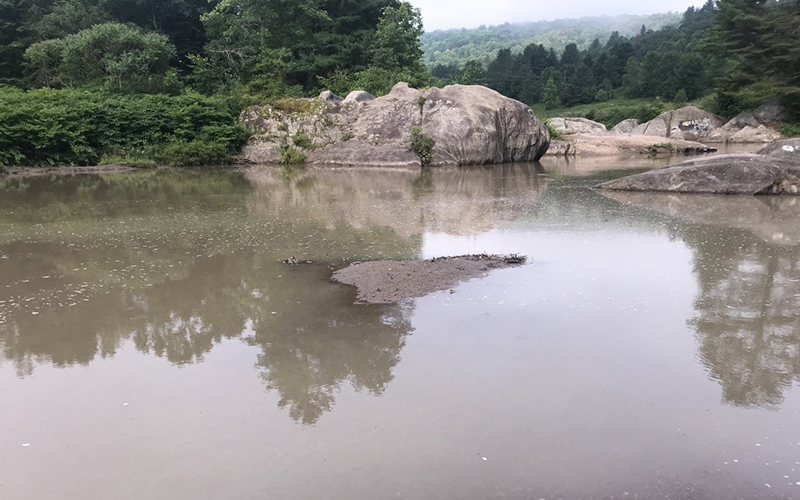On August 8 and 9, Friends of the Mad River’s (FMR) Mad River Watch volunteers visited field sites across The Valley in order to monitor water quality and make detailed environmental observations for their fifth field exploration this summer. This article is part of a series highlighting the questions and field work driving volunteers to find answers about the health of the Mad River watershed, as well as the community of supporters that make it possible.
Mad River Watch volunteers are part of a community science-based effort, rooted in observations, to better understand the ecological health of the whole watershed. The process of gathering observations starts as soon as volunteers arrive at their site. They note the weather conditions and any major changes, like fallen trees or new stream channels.
“Taking in the whole picture is a critical first step in any kind of field work,” explained Lisa Koitzsch, Mad River Watch coordinator. “Focusing too narrowly on chasing data points can lead to overlooking critical information and even add to the risk of an unsafe situation. It’s exciting to see black bears and other wildlife from a distance, but the last thing we want is to stumble into their space unaware.” In addition to her work with FMR, Lisa has also plays a key role as a field researcher studying wolves and moose in Yellowstone and Isle Royale National Parks.
Before moving on to take pollutant measurements, volunteers take a series of calibrated photos that will show change over time at each field site.
Water quality measurements of phosphate and temperature can tell a lot about conditions of the river directly and serve as indicators of other trends. The local context helps explain why certain data points show up. “When you look at a given field site, you can see the amount of shade the trees provide or take note of how close you are to a road or farm -- factors that can influence temperature or the presence of certain pollutants,” explained FMR director, Corrie Miller.
“After taking in the big picture, volunteers focus on more detailed observations. Our river and stream corridors are like highways for many kinds of wildlife,” said Koitzsch. “Paw prints or scat can tell us who has been there recently. By looking for signs like these, our volunteers are also learning more about the complexity of the natural world along the Mad River. Mad River Watch 2.0 is really about building a skilled corps of volunteers in conjunction with collecting data on the health of the watershed.”
In addition to tracking wildlife and identifying birds, volunteers also take note of the plant life and whether or not it is native, changes to the natural community through the season, impacts of recent weather conditions, as well as signs of human activities like trash or fire pits.
The same app that volunteers use for taking water quality data also allows them to record their observations by taking photos, videos and audio recordings of their field sites. Volunteers also keep field journals to draw sketches and write more detailed descriptions of their findings. “Handwritten notes and observations are still really useful for field work and are not going out of style any time soon,” said Koitzsch.
While visiting their field sites, many Mad River Watch volunteers find more artistic ways to connect with the river and its tributaries. "Some write poems or reflections on the watershed and others draw field sketches,” explained FMR board member Kinny Perot. “The sounds, the smells, the sights and the animals living along and traveling the stream, kids playing in the water and the cooling dips after working in the garden are all part of the flow of life here in The Valley. Reflections like these, as well as a belated celebration of FMR’s 30th anniversary, are what gave rise to Evan Primo’s newest musical composition, ‘My River Runs to Thee.’”
Scrag Mountain Music, led by bassist and composer Evan Primo and soprano Mary Bonhag, is hosting Abenaki singer-songwriter Brian Blanchette and the Aeolus Quartet at the Phantom Theater in Warren on Saturday, August 14, and 1 p.m. Tickets are ‘pay-what-you-can’ and can be purchased online at www.scragmountainmusic.org/watershed.
FROM THE FIELD
A volunteer at Shepard Brook noted the impacts of recent weather. “The water level was not noticeably higher even after a brief but torrential rain last night. Some suspended solids in the water, only noticeable in the sampling container, not in the running water. In contrast, the main body of the Mad was so muddy it looked like chocolate milk,” the volunteer reported.
Another volunteer noted their own impact on their field site at Dowsville Brook. “I saw a gray catbird, crows or ravens, I disturb a rock pigeon under the bridge each time I visit. As I was getting ready to leave, I flushed two brown/gray waterfowl who quickly took off downstream. Mallards perhaps?”
The mother/daughter volunteers at Ward’s Access have paid close attention to the way the river changes with time. “Erosion and deposition continue to change the shape of the beach but in small ways, the rocky beach is getting slightly smaller, with water encroaching, washing away on both east and west ends,” they reported.
This week saw 16 teams of volunteers visit 19 field sites. Water temperatures ranged from a low of 60.47°F at Rice Brook in Warren on Sunday to a high of 67.5°F at the USGS gage in Moretown on Monday. Over the summer, FMR will compile data and observations and share key findings and highlights in The Valley Reporter and online at friendsofthemadriver.org/madriverwatch.







